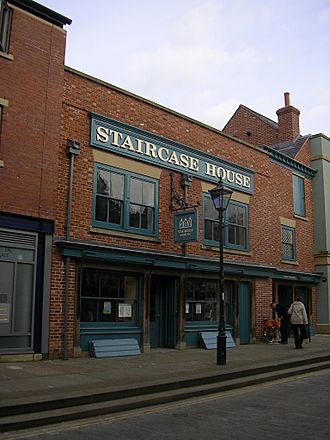Staircase House facts for kids
Quick facts for kids Staircase House |
|
|---|---|

The main entrance to Staircase House from the market place
|
|
| General information | |
| Architectural style | Medieval |
| Town or city | Stockport, Cheshire, now in Greater Manchester |
| Country | England |
| Coordinates | 53°24′44″N 2°09′15″W / 53.4123°N 2.154221°W |
| Completed | c. 1460 |
| Designations | |
|
Listed Building – Grade II*
|
|
| Official name: Staircase House | |
| Designated: | 27 April 1992 |
| Reference #: | 1356855 |
Staircase House, also known as Stockport Museum, is a very old and special building in Stockport, England. It was built around 1460, which means it's over 560 years old! This amazing medieval house is famous for its unique Jacobean staircase. It's a great place to learn about life in the past.
Contents
History of Staircase House
Early Days: From the 1400s to the 1800s
Staircase House is a timber building, meaning it was built mostly from wood. The oldest parts of the house date back to 1459 or 1460. We don't know much about its very first owners. Some people think it might have been the home of William Dodge, who was the Mayor of Stockport in 1483.
The first family we know for sure lived there was the Shallcross family. They owned the house from 1605 to 1730. In 1618, they added the special staircase that gives the house its name today. This staircase is called a "cage newel staircase" because its main posts go all the way up, making it look a bit like a cage. It has cool carvings all over the wood.
Over time, parts of the staircase were changed. This might have been to make it easier to move furniture around.
Saving the House: The 20th Century
Later on, Staircase House was used as a café and then for storage. Sadly, in 1995, there was a big fire that damaged the building. It was the second fire started on purpose at the house.
A local group called the Stockport Heritage Trust worked hard to save the house. They started their campaign in 1987. They convinced the local council not to knock it down. The Trust even helped figure out exactly how old the house was. They also helped get the house officially recognized as a "Grade II* listed building" in 1992, which means it's a very important historical building.
After the fire, the council bought the house and carefully restored it. They used old tools and methods to make sure it looked just like it did before.
Staircase House as Stockport Museum
Today, Staircase House is open to everyone as part of Stockport Museum. When you visit, you can see what life was like in Stockport during medieval times and the Renaissance. You can learn about how the town grew and how the house changed over hundreds of years, right up until the 1940s when someone last lived there.
The museum also has other cool things to see. It shows items from the Stone Age, the Iron Age, and medieval times. You can also learn about the local textile industry from the Victorian era, the impact of World War I, and the history of sport in Stockport.
See also
- Hat Works, a museum about making hats in Stockport
- Stockport Air Raid Shelters, underground tunnels used during World War II
- Grade II* listed buildings in Greater Manchester
- Listed buildings in Stockport

